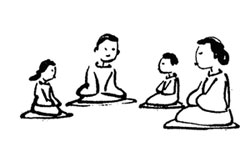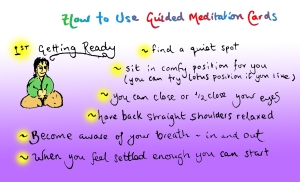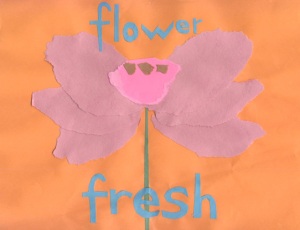 On our first session with the children in any retreat, we introduce to them the practice of listening to the bell and teach them to invite the bell. Sitting in a circle you can hold up the mini bell and ask if they know what it is. Ask if any of them have one at home. And what is the sound of the bell for? What do we do when we hear the bell? You can share that the sound of the bell is the voice of the Buddha, the voice of someone who loves them very much and only wants them to be happy and peaceful. So when we hear the bell, we stop what we are doing and just breathe. We have a chance to rest, to take a break, to enjoy ourselves. We are aware of our in and out breath.
On our first session with the children in any retreat, we introduce to them the practice of listening to the bell and teach them to invite the bell. Sitting in a circle you can hold up the mini bell and ask if they know what it is. Ask if any of them have one at home. And what is the sound of the bell for? What do we do when we hear the bell? You can share that the sound of the bell is the voice of the Buddha, the voice of someone who loves them very much and only wants them to be happy and peaceful. So when we hear the bell, we stop what we are doing and just breathe. We have a chance to rest, to take a break, to enjoy ourselves. We are aware of our in and out breath.
There may be other sounds that make them feel peaceful and happy, can they think of some? Maybe a bird singing, or the sound of laughter, or a baby cooing, or a bubbling brook, or the gentle sound of rain on the roof. These too are also the voice of the Buddha, the sound of awakening, and many sounds can help us come back to the place of calm and peace within us.
(You can read through the activities proposed and choose the ones you feel are appropriate for the group of children you will share with. You don’t need to do all the activities. Especially for younger children, you can shorten the following section.)
Awareness of Breathing
To help the children identify their breathing, ask the children to put their pointer finger horizontally under their nose to feel their breathing. What does their out-breath feel like? (Warm, moist?) Can you feel it? What does the in-breath feel like? You can share that we breathe all the time, but we are usually not aware of it and we take it for granted. But breathing is so important! What would happen to us if we couldn’t breathe?
You can also ask them to put their hands on their belly and notice what happens to their belly when they breathe in and what happens when they breathe out? (Tummy rises when I breathe in and falls when I breathe out). Feel this rhythm for a few moments in silence. Ask them how they feel when they just pay attention to their breathing. Often children share that they feel more peaceful and calm. (Sometimes it also helps to invite the children to lie down with their hands on their belly so they can feel its rise and fall more distinctly. You could also do this in partners and one child sits and gently rests her hands on her partners belly, who is lying down, and they can identify the in- and out- breath together, perhaps counting to a certain number, and then switch.)
You can share how learning to notice your breathing has helped you in difficult moments and how breathing with awareness like this can help them to calm down when they get upset or nervous and also can help them focus better at school, like when they take a test. Any time we are aware of our breathing, whatever we experience in the moment improves-if we are happy, we become happier and if we are suffering, breathing helps us suffer less, to calm down and see things more clearly.
Invite them to notice how many seconds their in-breath lasts and how many seconds their out-breath lasts. Our out breath may be a few seconds longer than our in breath. Ask different children to share how long their in and out-breaths are. They can let the in-breath be normal, but when they breathe out, they can breathe out all the air from their lungs, pulling in their abdomen and let the out-breath be a little bit longer. Then continuing in this style, of slightly lengthening the out-breath, invite them to take one in breath and one out breath and count it as ‘one’, then another in and out breath and count ‘two’ and go all the way up to 10. Ask them if it was easy or hard to pay attention to each breath for ten breaths, or if some lost count. And how it felt to breathe longer on the out-breath.
Breathing with the bell
Now invite the children to count how many breaths they take during one sound of the bell. Tell them you will invite the bell and that when they can no longer hear its resonance, they should raise their hand. Then they can share how many in and out breaths they took during the sound of the bell.
You can share them the poem for listening to the bell:
Breathing in: listen, listen
Breathing out: this wonderful sound brings me back to my true home.
We have a beautiful, safe place inside of us, where we can always go to, that is full of peace. The bridge that takes us to this island within us is our breathing. That’s why the bell is so important, because it helps us go back to this true home, this island of peace and clarity inside of us.
You can play a game where the children walk or run or dance around the room and when they hear the bell, they stop and breathe at least three times. Then continue moving.
Learning to invite the bell
(If there are children in the group who already know how to invite the bell, encourage them to teach the others). Ask the children to sit beautfully like a Buddha. We can only invite the bell when we are calm and peaceful, because the sound of the bell refelcts our mind. We can only help others be peaceful when we are also peaceful. So we recite this poem before we invite the bell:
Breathing in: Body, speech and mind in perfect oneness
Breathing out: I send my heart along with the sound of the bell
Breathing in: May those who hear it awaken from forgetfulness
Breathing out: And overcome all anxiety and sorrow
A more child-like version of the above poem is:
I am really here, with my mind and body united. I am calm and happy and I want this sound of the bell to help others feel calm and happy.
A fun exercise for later is to ask the children to write their own poems for listening to and inviting the bell and then to really practice using them whenever they hear or invite the bell.
Tell the children that we say “inviting the bell to sound” not “striking or hitting the bell” because it is a sound that can help many people and we always treat the bell with respect. Then we join our palms and bow to express our respect to the bell and also to show the unity of our mind and body. We pick up the bell and place it in the palm of one hand that remains flat, outstretched. With the other hand we pick up the inviter and wake up the bell. We wake up the bell to let others know a full sound is coming, so that they can come to a stop and enjoy it without being surprised. We breathe in and out once after the wake up sound and before making a full sound of the bell. The full sound should be strong and clear. If we mistakenly invite the bell too softly, we can invite a stronger sound straight away. Then we enjoy three in- and out-breaths. We place the bell down and bow. Invite all the children to try inviting the bell once.
The children really enjoy this and they are always incredibly quiet as they breathe three times in respect for each child’s sound of the bell. They often forget to wake up the bell, so you need to remind them. Sometime they are nervous and don’t invite it properly, just gently encourage them to try again. You can also ask them to share how they feel when they invite the bell.
Once they know how to invite the bell, you can ask the children to invite the bell whenever you begin and end sessions together. Remind them that they need to be calm and breathe in and out three times before they invite the bell. It helps to ask them to bring their hands from their lap up to their chest to indicate that they are breathing in and back down from chest to lap when they breathe out.
You can also encourage them to have a bell at home so that whenever the atmosphere in the family is tense, angry or carried away by forgetfulness, they can invite the bell and remind their parents and siblings to breathe. Many children do use the bell in this way at home.

This work is licensed under a Creative Commons Attribution-Noncommercial-No Derivative Works 2.5 India License.
Filed under: Practicing with the Bell | Tagged: breathing in, breathing out, children, inviting, kids, listening, mindfulness bell | Leave a comment »







You must be logged in to post a comment.